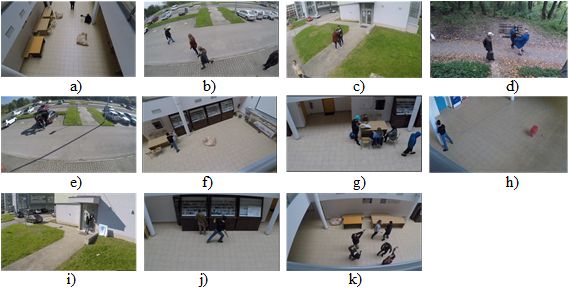LoDVP
Abnormal Activities
The data-set consists of videos with ten non-professional actors. The data-set contains 1069 videos. This data-set was divided into eleven classes (Begging, Drunkenness, Fight, Harassment, Hijack, Knife hazard, Normal videos, Pollution, Property damage, Robbery, Terrorism) as shown in the Fig. 1. These scenes were performed in different lighting conditions. During the creation of the data-set, our goal was to simulate the layout of the security camera system in public places such as in the building, in the parking lot and in nature. The Abnormal Activities data-set gives the diversity mainly in terms of actions in real environment with the presence of different variations in camera motion, appearance and position of the examined object and different illumination conditions, etc. The complexity of the data-set is influenced by the choice of categories, some of which are very similar, such as the Knife hazard and Fight categories. In the mentioned categories, the classification can be influenced by similar reactions of people to Fight but also to threatening with a Knife hazard, as well as similar movements during attack and Fight. The categories of Drunkenness and Begging can also be very similar, as the drunkard also appeals to annoy the people around him. These similarities between categories make the data-set we create more difficult to classify. Also, all categories created contain entries from different angles and backgrounds. Each category contains about 100 videos. In each video in all categories, the event takes place for entire video, so the length of the videos ranges from about 1 s to 30 s. Videos in the same category may have some features in common, such as the same person, similar or the same background, and camera angle. Uploaded videos are in .avi format. The all videos were recorded by two different cameras. The first camera was the GoPro Hero 4 and the second was the Lamax X7. The GoPro Hero4 camera can record in 4K resolution (UltraHD). It also supports lower video resolutions such as 1080p, 720p and 480p. It can take up to 120 frames per second, which is excellent for recording fast movements. The Lamax 7 camera can record in native 2.7 K resolution. It also supports lower video resolutions such as 1080p, 720p and 480p. It can take 60 frames per second.
The Abnormal Activities data-set consists of the following categories: Begging, Drunkenness, Fight, Harassment, Hijack, Knife hazard, Normal videos, Pollution, Property damage, Robbery, Terrorism. The mentioned types of categories can be seen in Fig.1.

Fig.1. Abnormal Activities Data-Set: a) Begging b) Drunkenness c) Fight d) Harassment e) Hijack f) Knife hazard g) Normal videos h) Pollution i) Property damage j) Robbery k) Terrorism
The Abnormal Activities data-set can be downloaded by link.
If you use this data set, please refer to the following technical report: A New Approach for Abnormal Human Activities Recognition Based on ConvLSTM Architecture.
Reference Dataset for Fotogrammetry
The dataset for the photogrammetric process comprises 54 images of owl objects captured using a Canon 6D Mark II and a Canon EF 24-105mm f/4L IS II USM lens. Figure 1. shows an object imaged in a controlled laboratory environment with precise lighting conditions, rotation angle, and two view planes. The equipment used to capture the object had a resolution of 26.2 Mpix. The owl was chosen as the object for photogrammetry due to its surface texture, granularity in space, and color. The photogrammetric test dataset includes a reference 3D model for comparison with the 3D model generated from the images. The object was utilized in experiments to generate 3D models with various modifications, such as altering the wavelength of visible light (refer to Figure 2.), using alternative sensing devices, and changing the sensing process from sequential to continuous (video) sensing.
The parameters at which the dataset of images was captured are listed in Table 1. A dataset was created based on the set parameters. Later, a 3D model was generated from this dataset for experimental purposes and comparison using statistical methods.

Picture 1 Test object (owl)

Picture 2 Changing the wavelength of visible light
| Table 1 Image parameters | |
|---|---|
| Format | JPEG |
| Picture Size | 6240 x 4160 |
| Resolution | 26.2 Mpix |
| Exposure Time | 1.3 s |
| ISO | 125 |
| Aperture | f/20 |
| Focal Length | 60 mm |
Dataset for photogrammetry is available at this link.
If you want to use dataset use reference to this articles: Digitalization and 3D Reconstruction of Object using Photogrammetry and Comparison of Various 4K Camera Systems for Photogrammetric Modeling
